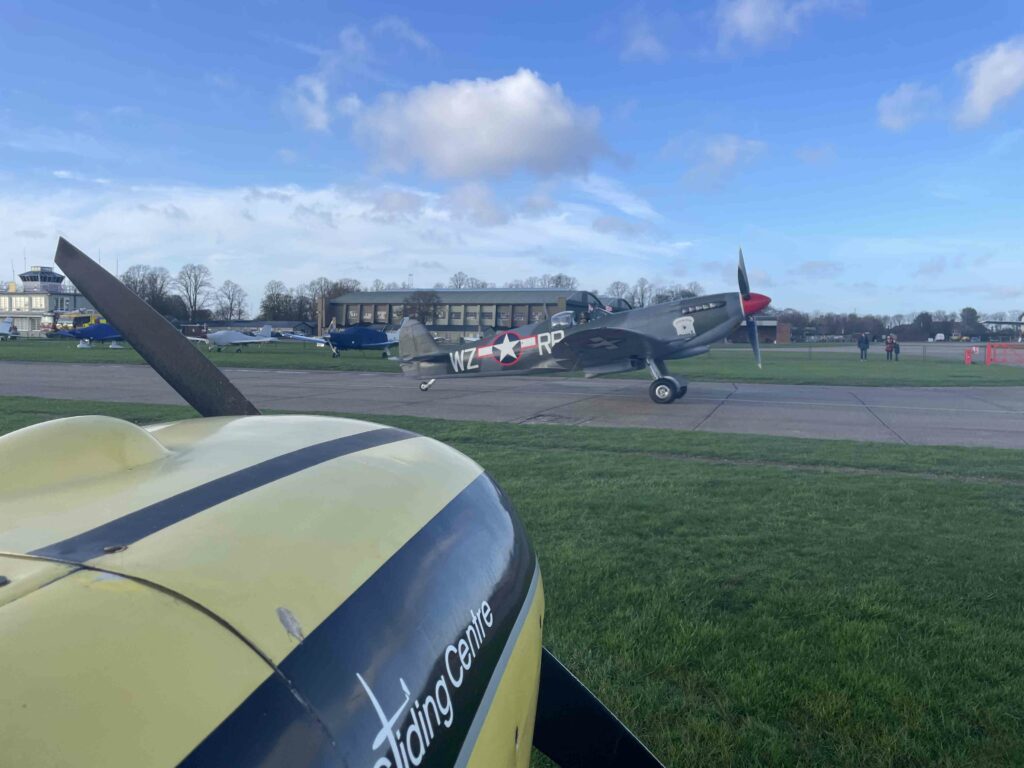
The IWM Duxford, apart from being a museum, is also an active airfield with intense general aviation activity, including training and warbird flying. It is possible for pilots to visit by air rathar than by ground. I was fortunate to be able to make this trip on 20/11/2022.
Duxford airfield is situated approximately 10 miles south of Cambridge. It has two parallel runways, 06R/24L is paved tarmac, and 06L/24R is grass, although they are not used simultaneously. The airfield has its own aerodrome traffic zone (ATZ) in class G airspace just north of the Stansted control areas, and has flight information service ‘Duxford Information’. Due to the close proximity to Fowlmere airfield, all circuits are to the south and non-standard joins apply. Duxford in the AIP.
I made the trip in the SF25C ‘Falke’ motorglider hired from Cambridge Gliding Club based at Gransden Lodge aifield which is only approximately 10 miles away. In any normal light aircraft the trip will only take just above 10 minutes, but we were not in any hurry so could afford to cruise at an economical and leisurely speed of 60 knots and give any hot areas a wide berth. The planned airtime is, therefore, 20 minutes.
Fuelled the aircraft with 5 gallons of AVGAS-100LL on this cold, blue wintery morning. Daylight is short and so is the airfield’s opening hours: 1000 to 1600 zulu daily, and sunset is only at 1602. Called in for PPR at 1038 in the morning. The FISO was friendly and welcoming as always, and give clear explanations of the expected joining procedures. A steady 10 knots westerly breeze is forecast to persist all day and any turbulence is insignificant. Prepared the aircraft for flight and blocks off at 1102. Airborne by 1110. It was rare to fly under the blue sky in this time of the year, although visibility was not the clearest.
Followed the Roman road down to Royston while climbing and maintaining 1500 ft altitude. There was no point in climbing very high for this short trip and the motorglider’s performance meant good landable fields (or even an airfield) was always within easy reach. If I climbed higher, I would have a hard time descending without overcooling the engine, as I needed to have the engine at a complete idle to get any reasonable descent rate. Saw a few outbound traffic from Duxford on the way in. Called Duxford Information at Royston overhead who was expecting us and was given the straightforward instruction to join downwind. A Cessna 152 from Classic Wings followed us in the circuit, which started catching up with me on base leg due to its faster speed, so it eventually had to extend its downwind. Turned final at the landmark roundabout and landed on the hard runway. I was initially offered the grass but practice on tarmac is always useful for me who learned at a gliding club.
The landing fee was £18.90 for anything below 1 tonne, for which all crew got admission to the museum. Had a look through the hangers and watched the warbirds flying around in between training traffic. I was on a quest to make contact with the local flying school but they are (again) not manned today.
Departed Duxford at 1300. As we were preparing the aircraft for flight two Spitfires taxied out of the apron for aerobatics. I parked particularly close to the taxiway to take a few good pictures. Made a straight out departure and essentially backtracking our way in. Duxford was busy at this hour with one Cessna touching-and-going, two Spitfires in the north vicinity (and I was explicitly instructed to stay in the south circuit to avoid conflict), and other GA activity. A PA28 was on its way to Bourn airfield which is our neighbour at Gransden Lodge, so they took the exact same routing as I did and overtook me before I even reached Fowlmere despite taking off later, and as soon as they levelled off they disappeared at the speed of 100 kts while I was in my unhurried cruise following the roman road to the north.
Arrived back at Gransden Lodge at 1345 well ahead of any forecast bad weather coming from Wales, and in time to do the week’s groceries.